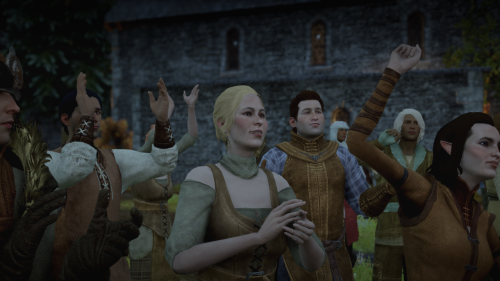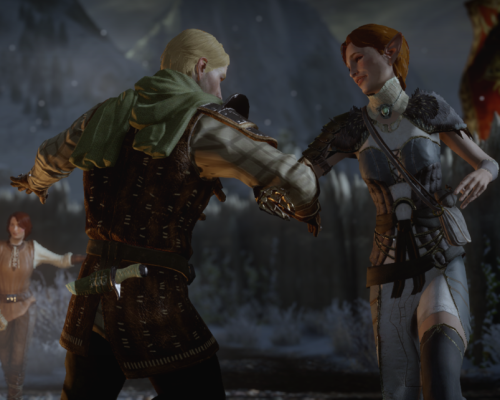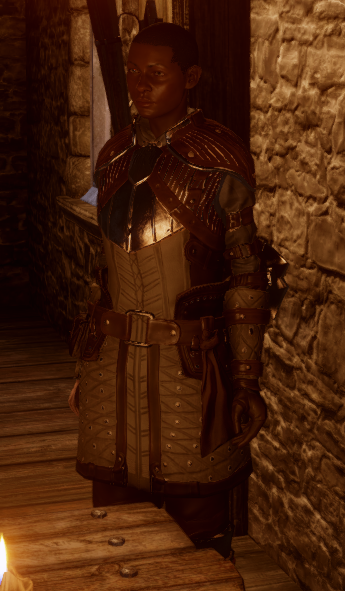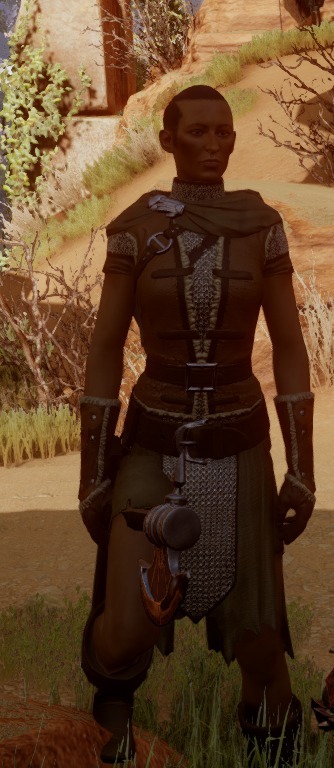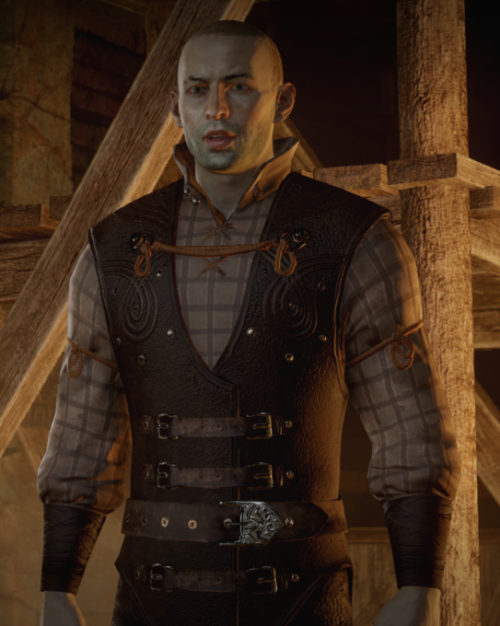Languages Of The Dragon Age
Languages of the Dragon Age
I am not a linguist. I have had loose associations with linguists in the past; I am at best passingly familiar with some general or interesting features of a scattered handful of languages and writing systems. This is more than enough to despise the way Dragon Age lore handles languages.
“Trade Tongue” is a convenient device for streamlined storytelling—you don’t have to worry about characters being able to understand one another—but it’s in the absolute top tier of poor world-building, especially for a fantasy medieval setting where information travels slowly and most people aren’t going to be doing much travel at all.
So, on the basis of some off-the-cuff reflection and with utter disregard for canon linguistics (aside from canonical names and vocab), I present a sketch of the known languages, and language families, of Thedas in the Dragon Age:
~ ~ ~ ~ ~ ~
Proto-Alamarri: Originating between the Waking Sea and the Frostback Mountains, the Alamarri language family is the most diverse in modern Thedas; Alamarri languages share phonetic and structural features with real-world Celtic and Germanic languages.
Fereldan: The common and court language of the kingdom of Ferelden; its use was suppressed among the nobility during the Orlesian occupation, but to little effect in the long term; it shares features with the Welsh and Gaelic languages.
Chasind: The language of the nomads who inhabit the Korcari Wilds south of Ferelden; although evidently related to its neighboring languages, it is not written and is little attested outside the Chasind tribes.
Avvar: Spoken by the semi-nomadic peoples of the Frostback Mountains, Avvar shares certain phonetic features with Andrisch by linguistic convergence.
Rivaini: The popular language of most of Rivain, to which the first Alamarri speakers came before the Tevinter period. Its vocabulary is strikingly varied from other Alamarri languages, including significant Neromenian borrowings, although it retains distinctively Alamarri phonology.
Andrisch: The dominant language of the Anderfels, Andrisch is less closely related to other Alamarri languages than any other pair in the family; it parallels real-world Germanic languages.
Marcher: The common speech of the Free Marches, characterized by its heavily Neromenian vocabulary fitted to Alamarri grammar. Spoken with significant regional lexical variation from Kirkwall to Ansburg and Wycome.
Neromenian: Originating in north-central Thedas, the Neromenian languages are the most widely spoken in the modern world; they correspond to real-world Romance languages.
Tevene: The language of the Tevinter Imperium and closest to (though by no means intelligible with) Neromenian, it has three distinct but mutually intelligible dialects in modern Thedas.
Classical: The dialect of Tevinter’s upper classes, featuring some modifications to vocabulary and pronunciation but grammatically very close to the Tevene of the old Imperium.
Vulgar: The dialect—or, more properly, dialects—of Tevene’s non-mage and slave castes, featuring significant regional variation, altered vocabulary, and grammatical innovations.
Arcanum: Not actually spoken in Tevinter, Arcanum is a preserved academic form of Ancient Tevene read (and loosely “spoken”) in southern Circles of Magi.
Orlesian: The language of the Orlesian Empire, Orlesian takes much of its vocabulary from languages of the Alamarri and Planasene families, although its grammatical structure remains distinctively Neromenian. Orlesian is the most widely spoken language in southern Thedas, used to facilitate trade between non-Orlesian kingdoms (although this is often lamented as a sign of persistent Orlesian influence).
Antivan: The language of the kingdom of Antiva, Antivan differs from Orlesian in the historical timing of its word loans and the decidedly higher concentration of Neromenian and Alamarri vocabulary.
Planasene: Originating in south-central Thedas, Planasene culture was largely wiped out by successive Tevinter and Orlesian expansion.
Nevarran: The only surviving Planasene language, sharing features of Classical Greek and Avestan, with significant influence from surrounding Neromenian languages, especially Orlesian.
Dwarven: The dominant language of the dwarven trade empire by the time of the First Blight, preserved in remarkably stable form in the surviving thaigs of Orzammar and Kal-Shirok. Its grammar and phonology parallel Uralic languages, especially Hungarian; it is written in an alphabetic runic script which is the basis for most human writing systems.
Elvhen: The language which was dominant in Arlathan before the rise of Tevinter, it is now spoken among the Dalish clans in diversely modified form, often drawing on regional human languages to replace vocabulary lost under Tevinter domination; these dialects are, however, transmitted carefully to ensure that they remain mutually intelligible. Elven script is alphabetic and unrelated to other Thedosian writing systems.
Qunlat: The language of the Qunari people and organized ideology, unrelated to the other languages of Thedas. Qunari script is logo-syllabic.
More Posts from Worlds-of-thedas and Others
Today is 11/11 which marks 101 years of Poland regaining independence and I thought it is a perfect time to publish a post that I’ve been working on for a while.
Ferelden from Polish Perspective aka Why We Can Relate to Dog Lords So Much.
This is a sort of compilation of my own thoughts I had while playing the games and various talks with my Polish friends. It is not supposed to force any ideas or teach others how to interpret the game. I just thought it could be entertaining for anyone interested in history and culture. I was trying not to elaborate too much on the subject here but it still ended up being A Very Long Post TM. To make this post a little neater to read, I divided this post into 4 sections:
1. History
2. Fashion and Food
3. Politics
4. Relationships with Other Countries
I will be very happy if you find a minute or two to read some of my points. If you have any additional questions or comments feel free to leave me a message :)
And once again - enormous thanks to @aeducanka for proofreading. I would be a poor mess without you.
Keep reading
no but how popular are maryden’s songs?? i know she’s playing in every tavern we go to but that could be a conveniently identical npc because inquisition didn’t have a ton of models lol
like what kind of notoriety does Scout Lace Harding have? is rook going to feel like they’re meeting, idk, billie jean. eleanor rigby. jolene herself
Dragon Age NPC Ages in DA: The Veilguard
This assumes that the 9 years between Dragon Age Inquisition and Dragon Age: The Veilguard refer to the Trespasser DLC (as in the last time Varric would have seen Solas), versus the start of Dragon Age Inquisition. This places DAV in 9:53. Characters who showed up in a previous game will not be repeated in the lists for later games they also appeared in (i.e., Leliana is under DAO, not DAI).
Read more for length & spoiler reasons. The ages listed are assuming they have not had their birthday in 9:53 yet.
Dragon Age: Origins - 9:30 - 23 years prior
Alistair Theirin - 42
Morrigan - 48
Leliana - 49
Zevran Arainai - 47
Oghren Kondrat - 65
Wynne - RIP (would've been 70)
Shale - Eternal
Sten (now Arishok) - 66
Loghain Mac Tir - 74
Anora Mac Tir - 49
Dragon Age: Awakening - 9:31 - 22 years prior
Nathaniel Howe - 52
Anders - 53
Sigrun - 47
Velanna - 47
Dragon Age 2 - 9:30-9:37 - 23-16 years prior
Hawke - 47
Carver/Bethany Hawke - 42
Fenris - ~53
Isabela - 53
Merrill - ~46
Sebastian Vael - 45
Aveline Vallen - ~58
Varric Tethras - 52
Dragon Age Inquisition - 9:41-9:44 - 12-9 years prior
Josephine Montilyet - 40
Cullen Rutherford - 41
Cassandra Pentaghast - 49
Solas - ~2000 (appears mid-40s)
Sera - 31
Vivienne de Fer - 56
Blackwall/Thom Rainier - 57
the Iron Bull - 49
Dorian Pavus - 41
Cole - Ageless (appears 20, or he may have aged into his 30s if he were made more human in DAI)
Kieran - 21
Thread: Sylvia Feketekuty on the influences of Emmrich and the Mourn Watch
The rest of this post is under a cut due to length and possible spoilers.
Sylvia Feketekuty: "I think I've gotten to most people’s questions, and I promised I'd talk about influences on Emmrich and the Mourn Watch before wrapping this up. So here we go! It took me while to figure out Emmrich's character voice. I'm happy with where I landed, but he was a tough one. A few books helped me out. MR James' Collected Ghost Stories (1890-1930) My favourite ghost stories of all time. James excels at building dread, at writing people finding strange things in books, or around the corner, or in the old lane at night."

"He was also an antiquarian and a scholar at Cambridge. I wanted Emmrich and the Watchers to feel formal, but not like they were from another epoch. James’ language, polished by a rich academic career, was an excellent benchmark for 'older, but not ancient'. E.g.: if using contractions was appropriate for James' time, it was appropriate for Emmrich. It freed me up, mentally speaking, to deploy them whenever they improved cadence or flow. Thomas Ligotti's Songs of a Dead Dreamer Fellow Ligotti fans may already be thinking Emmrich doesn't really share the philosophy underpinning Ligotti's work, and they’re right. However!"

"Songs of a Dead Dreamer is filled with fantastical imagery that’s a bit lusher than that found in Ligotti's later works. It was really good at bringing to mind the kind of moody, expansive dreamscapes I think our necromancer mentally occupies. It’s from a different book (Noctuary), but Ligotti’s “The Spectral Estate” also merits a mention. If you plunked it down in front of Emmrich to read, he’d know exactly what it was on about. The Romantic poets (or any poetry on similar themes: overpowering swells of emotion, the grandeur and awe of nature, love and loss and grief.) Palgrave's Golden Treasury was usually in reach."

"If I was in a jam, or psyching myself up for a scene, sometimes I’d read a few poems to get into the proper head space. Or just for the pleasure of it. Poems are great! Please take a link to Shelley's "A Dream of the Unknown", one of my favourites. [link] I also read a few books by morticians and funerary directors. A friend lent me Smoke Gets in your Eyes and From Here to Eternity by Caitlin Doughty (probably the most famous mortician on the internet?) I also checked out Nine Years Under: Coming of Age in an Inner-city Funeral Home by Sheri Booker."

"These books were full of lessons about how people react to death, how different cultures treat it, how anger and grieving express differently but come from the same wellspring. Very humane looks at how we deal with loss and other people. Moving on to non-books: My First Cadaver, a podcast of stories from medical students and medical professionals."

"I listened to a few episodes My First Cadaver, and there were some incredible tales in there. Gross (I could never be a doctor) but incredible. And I was struck by was how much students working on donated cadavers got attached to them. I can’t remember if it was in MFC or not, but there was one story about a medical student introducing his date to the cadaver he was working on like she was a beloved aunt. It was very sweet! Peter Cushing in Horror of Dracula (1958) and The Curse of Frankenstein (1957) These films are filled with handsome costumes, ominous sets, and the oversized passions I associate with gothic melodrama. Cushing's perfect in them."

"His portrayals of Van Helsing and Baron Frankenstein are brisk, determined, obsessive, and brimming with energy; they’re scholars who are experts in their field, yet still men of action. They felt like natural touchstones for a professor suddenly called to grand adventure. I also ended up reading Cushing's memoirs. In a bit of strange synchronicity, there were similarities between his life and traits I'd already decided to give Emmrich. Cushing came from a working-class family, had an intense phobia (his was of the dark), was vegetarian, and so on. I'd had no idea."

"(Humans tend to pattern-match, but it was a little eerie.) A side note: I've seen people speculate Emmrich was based off of Vincent Price. There’s a bit of the good Mr. Price in there, but Cushing got to play more heroic roles than he did. He felt more right to me. A second side note: did you know Vincent Price was a gourmand who loved to entertain? He and his wife Mary put out a beautiful cooking book, A Treasury of Great Recipes, filled with warm and charming commentary. If you're interested in that kind thing, highly recommended!"

"One influence when I was pitching the Memorial Gardens to the rest of the team was Swan Point cemetery in Rhode Island. It's where Lovecraft was buried, and like many a Weird Tales nerd before me, I was curious and wanted to see it."

"I wasn't prepared for was how lush the plants and flowers were, and how beautifully landscaped everything there is. Swan Point is a historical burial place, and also a carefully tended garden and arboretum. It stunned me. I'd never been in a cemetery like it. Emmrich complains about Hezenkoss making him play complicated wargames when they were students, and that one in particular had three separate rulebooks."

"I've seen people guess whether I was referencing D&D or Warhammer 40K. D&D was formative, and I know a frankly embarrassing amount about WH40K at this point (No regrets. Necrons and Admech 4-ever.*) But the origin is even sillier. *Why yes, Mechanicus 2 IS my most anticipated upcoming game. I used to own the first edition of a board game called Mansions of Madness, and was supposed to learn the rules so I could lead my friends through it. But come the day, I’d procrastinated, and was running short on time."

"Fantasy Flight's previous game in the same vein was Arkham Horror, and AH is not a simple game. But I remember being hopeful, as I peeled the shrinkwrap off, that maybe MoM would be easier to learn than AH. Have streamlined rules, or fewer things to remember. Then the top popped off, and three separate rulebooks fell out and slithered to the floor. (The DAV game’s not meant to be MoM, but the absurdity of that moment stuck with me.) (It's not the game's fault, by any means, that I was unprepared, and the session went as well as it could have with me flipping through the books going "Okay wait...hold on...I think that was here...no, wait.") The Nevarran hazelnut torte recipe is actually a family recipe from my grandmother, on my father's side. I’m beyond delighted people have actually made it. (Our recipe uses metric measurements, but the DA style guide uses imperial, so I was worried about the conversion. Looks like it went okay.)"

"On my mother's side of the family: my grandmother cooked and cleaned for a living, and my grandfather was a butcher. He passed away before I was born, and my grandmother when I was very young. So I gave Emmrich’s parents those professions as a little nod to the grandmother I only knew very little, and the grandfather I never met at all. I would’ve liked time with them both. And to end on a lighter note, "Ever thought of becoming a hat person?" is an extremely oblique reference to a line spoken to one of gaming's greatest characters: Murray, the demon skull from Curse of Monkey Island. (Curse is the first Monkey Island game I ever played, and therefore my favourite.)"

"Small bonus: here’s the music I listened to most while working on Emmrich and the Watchers. Some of it probably only makes sense to me, some of it seems thematically obvious. (I don’t have Spotify so best I can do is an itunes screenshot.)"

"Not on the screenshot because I changed PCs halfway through, but I also listened to a lot of music from Cryo Chamber, a great dark ambient label. [link] And their sister label, Cryo Crypt, which does "Dark Fantasy Dungeon Synth." [link] And also Allicorn IS on the screenshot but I think I've listened to his stuff on every game I've worked on by now. [link]"
[thread source link]
---
Bonus: follow-up comments and exchanges -
User: "I KNEW the torte was somebody’s family recipe!!" // Sylvia: "My only regret is that the icing was originally a stove-boiled icing made with eggs and chocolate and butter emulsified together. I couldn't get it working, however, these past few years. I think we lost some crucial part of the steps when trying to write out a clean copy. So I went with ganache for the game, because I didn't want to print something that didn't work, and I've used ganache myself. It's good! But I'm going to try to replicate the original again one day." [source, two] // User: "I noticed that sometimes, ingredients doesn't react the way they used to and part of that is probably due to some "industrial" changes in the recipe for ingredients like chocolate or butter to cut the cost of making them, imho. It's sad because it means we lost a very specific way to do things..." // Sylvia: "Yeah, that was the first thing a friend who bakes a lot suggested. I wonder if I was a victim of "Buttergate" when Canadian cows were being fed so much palm oil butter was harder to spread as a result. After a long search, I found a local place that makes butter that actually tastes good, which is an incredibly sad sentence to have to type out." [source, two]
Sylvia, re: Vincent Price being a gourmand and his cooking book: "It's extremely cool. My library had a copy and I remember it being pretty big, too." [source]
User: "I was following this thread and I'm delighted about all of these facts and information. Thank you for sharing!" // Sylvia: "Aw thank you! And thanks for reading, it was nice to unpack all the stuff kicking around my mental attic." [source]
User, re: MFC: "Sorry to post again but this one got me- my mom is a doc, and i remember her telling me stories of the cadaver she worked on (evidence of different surgeries she had, the cancer she had, etc), and mom always ended her stories saying how thankful she was to her. It really does stick around." // Sylvia: "No need to apologize, I liked hearing about your mom's reaction! It's exactly what I kept hearing and reading about, a sense of reverence for the gift." [source]
Sylvia: ""The irony that I had to convert the measurements back to metric" Haha. I tried to get as close as I could. Here's the written down metric version of the cake batter. It's an older recipe so I had to try to guess what a "knife tip" ended up as." [source]

A user on the torte being a family recipe: "Oh my gosh 🥹 that makes it all even lovelier!" // Sylvia: "Thanks! I was really excited to share the family recipe, it's a bit of work but it's one of my favorites." [source]
A user under the post about MR James' Collected Ghost Stories: "So you're probably the one behind the mysterious bronze whistle, I take it?" // Sylvia: "Haha, guilty. Cameron Harris, our editor, helped me figure out a phonetic guide to the latin. (If it fails anywhere it's very likely my fault.)" [source]
User: "As an avid Emmrich lover & someone trying to write some Emmrich POVs in my Emrook fanfictions, I can not thank you ENOUGH for this wealth of info / music inspo to go off of" // Sylvia: "Thank you! (Seriously though some of those songs probably only make sense to me, they're not all thematically on point, but some are. Hope you enjoy!)" [source]
User: "As another "needs a million hours of droning ambient music to write" writer I appreciate these greatly" // Sylvia: "We both have good taste! 🎶" [source]
User: "Thank you for writing out this list!! Peter Cushing makes so much sense as an influence. I love the variety of media here, it gives me so much new stuff to check out!" // Sylvia: "Thank you for reading! If you do check out some of this stuff, hope you enjoy!" [source]
Sylvia: "thanks so much, and for reading the thread! It was fun to write." [source]
User: "Thank you for sharing these books!I was looking for a good ghost book" // Sylvia: "Thanks! Hope you enjoy James. "Oh, Whistle, and I'll Come to You, My Lad" was the first story of his I read and I'll never forget that experience." [source] // Sylvia: "I just love the mood James could create, so much." [source]
User: "ELECTRIC SIX MENTION" // Sylvia: "My greatest favorites, now and forever." [source]
Sylvia: "Please archive away, I am intent on deleting the account eventually but it'd be nice to know people could look this stuff up later if they're curious. (Future generations need to know which Atrium Carceri tracks I listened to!)" [source]
User: "Amongst many things, not the least of which is the gratitude and delight of having your fantastic insight into the writing process of Emmrich, my grandmother’s hazelnut torte is fantastically close to the Nevarran version which was a delightful discovery." // Sylvia: "Ah now nice. I assume she was also central/eastern European then? I suspect it was a popular recipe at a certain time." [source]
User: "As an ex-mortician turned game writer, this was a FASCINATING read!" // Sylvia: "Haha, I definitely took inspiration from morticians! (Thank you for checking it out, that thread got long)" [source]
[thread source link]
One of the craziest things about Dragon Age (and this might help those of you who don’t go here kind of understand what people are yelling about in the coming months) is its lore. But I don’t mean that in the way you’re probably thinking.
I mean, quite literally, the way it presents its lore to you. In picking up notes and books as you go along and sifting through the codex, the game effectively asks you to act as an anthropologist. You’re met with a host of primary and secondary sources, some many hundreds of years apart from one another, written by anyone from the highest Chantry scholar to John Farmer, and you’re meant to constantly be questioning every piece of information you’re given. What biases are present in what I’m reading? What is fact and what is complete fabrication and what is, potentially, a slightly twisted version of a fact? How does one source potentially contradict another? The lore is one giant mystery-puzzle that you get to piece together across three games, and what conclusions you draw are going to be entirely different from someone else’s, and so on.
And yet, the series still does something even cooler than any of that. You realize, at a certain point, that this idea you have been engaging with on a meta-level — this idea that history is biased and fallible, that it’s written by colonizers and conquerers, genocidal racists and religious zealots, that the ability to control historical narrative is the prize you win for spilling the most blood — that idea is one of, if not perhaps THE most important, overarching theme of the series. The way that we remember history — what we remember and what we don’t, and why — and the impact that has on people on a sociological, political, cultural and psychological level, on both a macro and micro scale. It’s the entire thesis of the series’ main villain’s whole motivation.
And there’s gonna be a lot of people that don’t care about all that but me personally it makes me want to gnaw on a cinder block and scratch at my walls
The world is in great peril, and you are the unlucky protagonist who must save it! Spin this wheel three times and get your Dragon Age party that you're stuck trying to save it with.
Feel free to reroll repeats. Most are companions, but there are also a few companion-adjacent possibilities. You can assume that you as the protagonist have a basic level of combat competency even if you don't in real life, so don't worry about yourself

DA Cinematic Designer Derek: "I can confidently say myself that when I messed around with the character creator, it was absolutely one of the best I’ve EVER played with. And that was in its earlier stages." [source]

they said it couldn't be done etc etc [x]
fun little details around minrathous
so, because I love little worldbuilding details, I decided to scour minrathous and ended up finding lots of unique assets! some of my favorites below:
1. the viper watching rook from the rooftops

I already dedicated a one-off post to this, but the first time you travel to minrathous after the prologue, you can catch a glimpse of the viper on the rooftops.
2. the viper's wanted poster

speaking of the viper, he decides to meet up with you literally right across from a wanted poster of himself. so far, this is the only copy I've found, so it may be an entirely unique asset intentionally placed there. thanks to caitie ghiil dirthalen's post on the tevene alphabet, I was able to translate the heading as 'reward.' the second line? lorem ipsum lmao.
3. murder by candlehop

you can find this venatori surrounded numerous candlehops in a small locked alcove; I believe there are at least 10 candlehops in the vicinity?
4. serpents, serpents everywhere



unsurprisingly, snakes turn up a lot in the architectural details; you can find them in braziers, gutters, pipes, pillars, etc.
5. the cobbled swan sign

I was absolutely delighted to find out that the cobbled swan - the tavern you visit for several major story beats - has a unique sign. it's so cute :') (and contains another snake).
6. tevinter cuisine



the cobbled swan also offers an interesting look at some culinary staples of minrathous. the calamari and oysters were expected since it's a coastal city, but the scorpion pasta was a surprise...
-
 maggots-in-the-veins liked this · 11 months ago
maggots-in-the-veins liked this · 11 months ago -
 casa-dei-corvei reblogged this · 11 months ago
casa-dei-corvei reblogged this · 11 months ago -
 onuen liked this · 11 months ago
onuen liked this · 11 months ago -
 worlds-of-thedas reblogged this · 11 months ago
worlds-of-thedas reblogged this · 11 months ago -
 worlds-of-thedas liked this · 11 months ago
worlds-of-thedas liked this · 11 months ago -
 crynwr-drwg liked this · 1 year ago
crynwr-drwg liked this · 1 year ago -
 a-boros-named-seamus reblogged this · 1 year ago
a-boros-named-seamus reblogged this · 1 year ago -
 a-boros-named-seamus liked this · 1 year ago
a-boros-named-seamus liked this · 1 year ago -
 everythingispoetry liked this · 2 years ago
everythingispoetry liked this · 2 years ago -
 theleadcinnabon liked this · 2 years ago
theleadcinnabon liked this · 2 years ago -
 magneticmage liked this · 2 years ago
magneticmage liked this · 2 years ago -
 mysterious-cuchulainn-x reblogged this · 2 years ago
mysterious-cuchulainn-x reblogged this · 2 years ago -
 sspellweaver reblogged this · 2 years ago
sspellweaver reblogged this · 2 years ago -
 spacevulpix reblogged this · 2 years ago
spacevulpix reblogged this · 2 years ago -
 saint-satias liked this · 2 years ago
saint-satias liked this · 2 years ago -
 saint-satias reblogged this · 2 years ago
saint-satias reblogged this · 2 years ago -
 dzikieziola liked this · 2 years ago
dzikieziola liked this · 2 years ago -
 rowanisnotatree liked this · 2 years ago
rowanisnotatree liked this · 2 years ago -
 laurythelatrator liked this · 2 years ago
laurythelatrator liked this · 2 years ago -
 ftmshepard reblogged this · 2 years ago
ftmshepard reblogged this · 2 years ago -
 ftmshepard liked this · 2 years ago
ftmshepard liked this · 2 years ago -
 mysterious-cuchulainn-x reblogged this · 2 years ago
mysterious-cuchulainn-x reblogged this · 2 years ago

A collection of canonical and non-canonical lore of Thedas, and archive of the amazing meta this fandom has produced. All work will be properly sourced and any use of other's work should conform to their requests. (icon made by @dalishious)
72 posts
